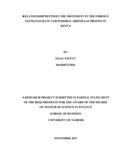| dc.description.abstract | This study examined the relationship between movement in the Foreign Exchange rate
and possible Arbitrage Profits in Kenya, covering a ten year period from January 2007 to
December 2016. The study used secondary data from Central Bank of Kenya (CBK). In
determining arbitrage profits, the researcher computed Triangular Arbitrage. Movement
in foreign exchange rate was computed as well by getting the end month closing rate of
the KES/USD and KES/EUR and subtracting the previous month’s rate. The other
explanatory variables were CBK rate and Inflation rate. Descriptive analysis was done on
the variables. It was established, over the research period, changes in the CBK Rate was
minimal, as compared to changes in inflation. The Mean and Standard deviations of
arbitrage profit, change in Euro value, and change in Dollar value was measured. It was
found that over the ten year research period, the standard deviation of the change in the
value of Euro was twice of the change in the value of the Dollar. Pearson correlation was
employed to analyze the level of association between the arbitrage profit and the
explanatory variables and the results shows a significant weak positive correlation
between arbitrage profit and change in dollar value. CBK rate have significant weak
negative correlation with change in euro value and change in dollar values. Arbitrage
profit was regressed against change in dollar value, change in euro value, central bank
rate as well as inflation. It was found that there is a low degree of correlation between the
arbitrage profits and the explanatory variables. R squared, being the coefficient of
determination indicates the deviations in the response variable that is as a result of
changes in the predictor variables. The R2 indicates that only 8% of the variation in
arbitrage profit is explained by change in dollar value, change in euro value, central bank
rate and inflation rate. This means there are other micro and macro-economic factors,
such as Balance of Payment, Country’s Debt level, Banks Interest rates, other investment
opportunities available in the market, which could explain the variation in arbitrage
profits. A one unit increase in the dollar value increases the arbitrage profit by three
hundred and twenty units while a unit increase in the rate of inflation increases the
arbitrage profit by one hundred and seven units. However, changes in euro value has no
significant effect on the arbitrage profit. The results of this study suggest that arbitrageurs
may monitor the movement of the Kshs/USD exchange rates to identify arbitrage
opportunities and make profits. The level of inflation rate in the country could also be a
guide to arbitrageurs in identifying triangular arbitrage opportunities in the foreign
exchange market | en_US |



